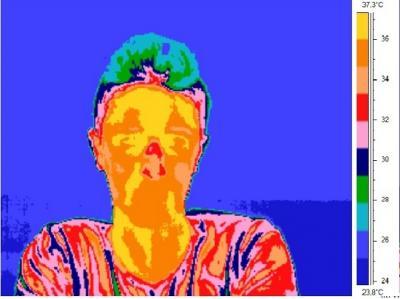It sounds as suspect as every other lie detector test, but psychologists have used thermography, a technique based on determining body temperature, to determine if someone is telling the truth.
They say a person telling a lie has been shown to undergo a "Pinocchio effect" - their nose changes. But it does not grow, instead they can detect an increase in the temperature around the nose and in the orbital muscle in the inner corner of the eye. Plus, they say when people exert a considerable mental effort the face temperature drops - and the opposite happens during an anxiety attack.
Thermography is a technique based on body temperature applied in many fields. Thermographic cameras have a wide range of uses such as measuring energy loss in buildings, indicating respiratory diseases in bovine animals or rabies in raccoons. Thermography was developed during World War II to detect the enemy at night.
Excitement is the Same in Men and Women
University of Granada researchers Emilio Gómez Milán and Elvira Salazar López say that sexual excitement and desire can be identified in men and women using thermography, since they induce an increase in chest and genital temperature. Their new study says that physiologically men and women show excitement the same way even though women say they are not excited.
And when a mental effort is made, like performing a difficult task or being interrogated about something or lying, a person's face temperature changes.
They say the insula is activated as part of the brain's reward system when we experience real feelings - qualias - and that the insula is involved in the detection and regulation of body temperature. A strong negative correlates insula activity and temperature increase: the more active the insule (the greater the feeling) the lower the temperature change, and vice versa, the researchers state.

This shows thermal images obtained with the thermograph. Credit: University of Granada
The Thermal Footprint of Flamenco
Researchers also determined the thermal footprint of aerobic exercise and different dance modalities such as ballet. When a person is dancing flamenco the temperature in their buttocks drops and increases in their forearms. That is the thermal footprint of flamenco, and each dance modality has a specific thermal footprint, professor Salazar explains.
The researchers demonstrated temperature asymmetries in both sides of the body and local temperature changes are associated with the physical, mental and emotional status of the subject. The thermogram is a somatic marker of subjective or mental states and allows us see what a person is feeling or thinking, professor Salazar states.
Finally, thermography is useful for evaluating emotions (since the face thermal pattern is different) and identifying emotional contagion. For example, when a highly empathic person sees another person having an electric discharge in their forearm, they become infected by their suffering and temperature in their forearm increases.
In patients with certain neurological disease such as multiple sclerosis, the body does not properly regulates temperature, which can be detected by a thermogram. They say thermography can also be applied to determine body fat patterns, which is very useful in weight loss and training programs and can even assess body temperature in celiac patients and in patients with anorexia.






Comments